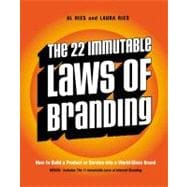This marketing classic has been expanded to include new commentary, new illustrations, and a bonus book: The 11 Immutable Laws of Internet Branding
Smart and accessible, The 22 Immutable Laws of Branding is the definitive text on branding, pairing anecdotes about some of the best brands in the world, like Rolex, Volvo, and Heineken, with the signature savvy of marketing gurus Al and Laura Ries. Combining The 22 Immutable Laws of Branding and The 11 Immutable Laws of Internet Branding, this book proclaims that the only way to stand out in today's marketplace is to build your product or service into a brand—and provides the step-by-step instructions you need to do so.
The 22 Immutable Laws of Branding also tackles one of the most challenging marketing problems today: branding on the Web. The Rieses divulge the controversial and counterintuitive strategies and secrets that both small and large companies have used to establish internet brands. The 22 Immutable Laws of Branding is the essential primer on building a category-dominating, world-class brand.
"Al Ries's laws of marketing turned my software company into a worldwide brand and the dominant player in a whole new software category. Anyone looking to market their company successfully has to read The 22 Immutable Laws of Branding." -- Patrick M. Sullivan, CEO, SalesLogix
"I could only wish that I'd had access to this book at the start of my career, the insights it provides are indispensable to anyone seeking to build their business into a recognized brand." -- Philip J. Romano, CEO, Romano Enterprises








